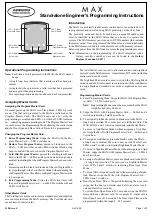LPC5411x
All information provided in this document is subject to legal disclaimers.
© NXP Semiconductors N.V. 2018. All rights reserved.
Product data sheet
Rev. 2.1 — 9 May 2018
2 of 105
NXP Semiconductors
LPC5411x
32-bit ARM Cortex-M4/M0+ microcontroller
ARM Cortex-M0+ core
ARM Cortex-M0+ processor, running at a frequency of up to 100 MHz (uses the
same clock as Cortex-M4) with a single-cycle multiplier and a fast single-cycle I/O
port.
ARM Cortex-M0+ built-in Nested Vectored Interrupt Controller (NVIC).
Non-maskable Interrupt (NMI) input with a selection of sources.
Serial Wire Debug with four breakpoints and two watch points.
System tick timer.
On-chip memory:
Up to 256 KB on-chip flash program memory with flash accelerator and 256 byte
page erase and write.
Up to 192 KB total SRAM consisting of 160 KB contiguous main SRAM and an
additional 32 KB SRAM on the I&D buses.
ROM API support:
Flash In-Application Programming (IAP) and In-System Programming (ISP).
ROM-based USB drivers (HID, CDC, MSC, and DFU). Flash updates via USB is
supported.
Supports booting from valid user code in flash, USART, SPI, and I
2
C.
Legacy, Single, and Dual image boot.
Serial interfaces:
Flexcomm Interface contains eight serial peripherals. Each can be selected by
software to be a USART, SPI, or I
2
C interface. Two Flexcomm Interfaces also
include an I
2
S interface. Each Flexcomm Interface includes a FIFO that supports
USART, SPI, and I
2
S if supported by that Flexcomm Interface. A variety of clocking
options are available to each Flexcomm Interface and include a shared fractional
baud-rate generator.
I
2
C-bus interfaces support Fast-mode and Fast-mode Plus with data rates of up to
1Mbit/s and with multiple address recognition and monitor mode. Two sets of true
I
2
C pads also support high speed mode (3.4 Mbit/s) as a slave.
USB 2.0 full-speed device controller with on-chip PHY and dedicated DMA
controller supporting crystal-less operation in device mode using software library.
See Technical note TN00031 for more details.
Digital peripherals:
DMA controller with 20 channels and 20 programmable triggers, able to access all
memories and DMA-capable peripherals.
Up to 48 General-Purpose Input/Output (GPIO) pins. Most GPIOs have
configurable pull-up/pull-down resistors, programmable open-drain mode, and
input inverter.
GPIO registers are located on the AHB for fast access.
Up to eight GPIOs can be selected as pin interrupts (PINT), triggered by rising,
falling or both input edges.
Two GPIO grouped interrupts (GINT) enable an interrupt based on a logical
(AND/OR) combination of input states.
CRC engine.


















